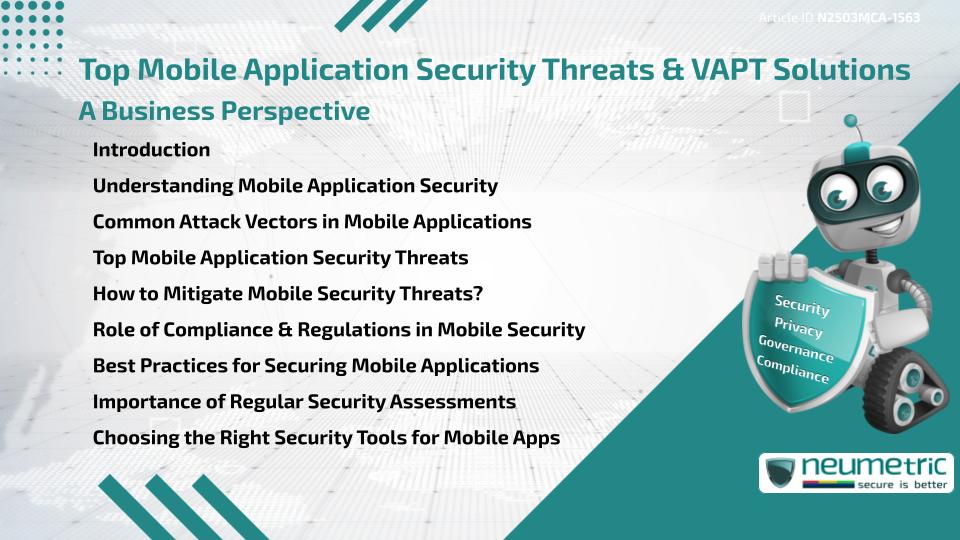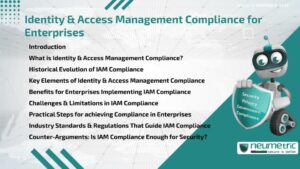Table of Contents
ToggleIntroduction
Mobile Applications are a critical part of daily life, used for Banking, Communication & Business Operations. However, as their usage increases, so do Security Risks. Understanding the Top Mobile Application Security Threats is essential to protect User Data & Ensure safe interactions. This Article explores Key Threats, Attack Vectors & Ways to mitigate Risks effectively.
Understanding Mobile Application Security
Mobile Application Security refers to the strategies & measures used to protect Mobile Apps from Cyber Threats. This includes securing User Data, preventing unauthorised access & ensuring Compliance with Security Regulations.
Common Attack Vectors in Mobile Applications
Cybercriminals Exploit various Vulnerabilities in Mobile Apps to compromise Security. The most common Attack Vectors include:
- Insecure Data Storage – Unprotected Local Storage can lead to Data Theft.
- Weak Authentication – Poor Password Policies allow Unauthorised Access.
- Unsecured Network Connections – Using Unsecured Wi-Fi exposes Data to Interception.
- Code Tampering – Attackers modify Applications to introduce Malicious Functions.
Top Mobile Application Security Threats
1. Insecure Data Storage
Storing Sensitive Information in an Unencrypted Format makes it easy for Attackers to access Personal or Financial Data.
2. Weak Authentication & Authorisation
Many Mobile Apps lack strong Authentication measures, making it easier for Attackers to gain unauthorised access.
3. Unsecured APIs
Poorly secured Application Programming Interfaces [APIs] can expose Sensitive Data & Functions to Attackers.
4. Malware & Trojans
Malicious Applications disguised as Legitimate ones can steal User Data or take Control of a Device.
5. Phishing Attacks
Mobile Phishing Scams trick users into revealing Sensitive Information through Fake login Pages or Emails.
6. Code Injection Attacks
Attackers inject malicious Scripts into Mobile Applications to gain Control or Extract Data.
7. Reverse Engineering
Hackers Decompile & Analyse App Code to identify Vulnerabilities or Modify App behavior.
8. Session Hijacking
Intercepting Session tokens can allow Attackers to impersonate Users & Gain access to Accounts.
9. Lack of Secure Communication
Failure to use Encrypted communication channels exposes Sensitive Data to eavesdroppers.
How to Mitigate Mobile Security Threats?
Organisations can reduce Mobile Security Risks by:
- Implementing strong Encryption for Data storage & communication.
- Enforcing Multi-Factor Authentication [MFA] for Access Control.
- Regularly Testing APIs for Vulnerabilities & Securing them properly.
- Using Anti-malware Solutions to detect & prevent Malicious Software.
- Educating Users on Phishing Risks & Safe Mobile practices.
Role of Compliance & Regulations in Mobile Security
Standards like the General Data Protection Regulation [GDPR] and Payment Card Industry Data Security Standard [PCI DSS] provide Security Guidelines for Mobile Applications. Compliance ensures Data protection & minimises Security Risks.
Best Practices for Securing Mobile Applications
- Secure Code from the Development Stage.
- Implement strong Authentication Mechanisms.
- Regularly update Applications to fix Vulnerabilities.
- Use Penetration Testing to identify Security Gaps.
Importance of Regular Security Assessments
Performing routine Security Audits & Vulnerability Assessments helps detect & fix potential Risks before they are Exploited by Attackers.
Choosing the Right Security Tools for Mobile Apps
Investing in the right Security solutions, such as Mobile App Security Scanners & Encryption Tools, enhances App protection.
Conclusion
With Mobile Applications handling Sensitive Data, Security Threats continue to evolve. Understanding the Top Mobile Application Security Threats & implementing effective Countermeasures is crucial for protecting Users & Businesses from Cyber Risks.
Takeaways
- Mobile Apps are Prime Targets for Cybercriminals due to widespread usage.
- Common Threats include insecure Data storage, Phishing, API Vulnerabilities & Malware.
- Security Measures like Encryption, Strong Authentication & Regular Updates reduce Risks.
- Compliance with Security Regulations strengthens Mobile Application Security.
FAQ
What are the Top Mobile Application Security Threats?
The biggest Threats include insecure Data storage, Weak Authentication, Unsecured APIs, Malware, Phishing & Reverse Engineering.
How can Developers Secure Mobile Applications?
Developers can Secure Apps by implementing Strong Encryption, Multi-Factor Authentication, Secure Coding Practices & Regular Updates.
Why are Unsecured APIs a Major Threat?
Unsecured APIs expose Sensitive Data, making it easy for Attackers to exploit Application Functions & Gain Unauthorised Access.
How does Malware affect Mobile Applications?
Malware can steal User Data, modify App Functions or take full control of a Device, leading to Data Breaches & Security Risks.
What Role does Encryption play in Mobile Security?
Encryption protects Data by converting it into a Secure Format, preventing Unauthorised Access even if the Data is Intercepted.
How do Phishing Attacks compromise Mobile App Security?
Phishing Attacks trick users into providing Login Credentials or Sensitive Information through fake Emails or Websites.
Why is Multi-Factor Authentication important for Mobile Apps?
MFA adds an extra layer of Security by requiring additional Verification, reducing the Risk of Unauthorised Access.
How often should Mobile Apps be updated for Security?
Apps should be updated regularly to Patch Security Vulnerabilities & Protect against emerging Threats.
What Security Tools are best for Mobile Application protection?
Security Tools such as Mobile App Security Scanners, Penetration Testing Software & Encryption Solutions help protect Apps from Threats.
Need help?
Neumetric provides organisations the necessary help to achieve their CyberSecurity, Compliance, Governance, Privacy, Certifications & Pentesting goals.
Organisations & Businesses, specifically those which provide SaaS & AI Solutions, usually need a CyberSecurity Partner for meeting & maintaining the ongoing Security & Privacy needs & requirements of their Clients & Customers.
SOC 2, ISO 27001, ISO 42001, NIST, HIPAA, HECVAT, EU GDPR are some of the Frameworks that are served by Fusion – a centralised, automated, AI-enabled SaaS Solution created & managed by Neumetric.
Reach out to us!





